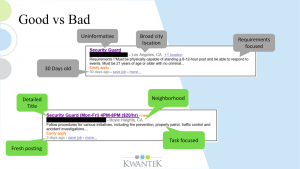HOW EVERY SECURITY COMPANY CAN GROW THROUGH ADDING NEW SERVICES
Chris Anderson, Thinkcurity, Silvertrac, CALSAGA Network Partner
No matter what stage a private security company is in, growth is a primary goal. The simple answer to growth is winning more contracts. But that is never as simple as it sounds.
There are a lot of methods to secure more contracts as a security provider and it’s helpful to consider them. But one of the most effective ways is to diversify the security services that you offer.
It’s clear that security services are not one-size-fits all. Potential clients will be looking for services that fit their specific wants and needs. So how do you add services to your operation that will win you more bids so you can grow year after year?
- Know what security services are in high demand
- Learn how to effectively add services based on your current size
If you read this article and still want more resources, check out the day 2 keynote speech from the Virtual Physical Security Summit. Steve Vitale talks all about how to incorporate new security services into your operation.
Types of Security Services to Add
Knowing what specific services potential clients want will help a lot as you start to consider which services you should add to your operation. For example, 2020 changed the physical security industry dramatically and many security clients want things like remote guarding services or security guards trained in de-escalation tactics.
With that in mind, take a look at these 5 services that show big potential for growth in the industry.
- Security Risk Assessments
Risk assessments are a service that every security company should offer no matter what size or stage they are because they affect the rest of your service offerings.
When you do a risk assessment, you will be able to see what specific security needs a current or potential client has and how you can address them with the services you provide. Risk assessments can also tell you what services you might need to add to your business.
An initial assessment and property walk won’t tell you everything you need to know about a new property. Steve Vitale – an expert in this area – recommends doing 30, 60, and 90-day risk assessment check-ins with every new client.
- Off-Duty Officers
Off-duty police officers, retired police officers, and veterans are great assets to any physical security company. These are people with tons of experience and training – especially in skills like de-escalation and tactical communication.
Police officers and veterans also allow you to justify higher bill rates (just keep in mind you usually have to pay them more, too). Clients tend to feel better about having experienced, highly trained security officers on the job and are willing to pay for it.
- Security Technology
The world runs on information and your clients are no different. Offering security technology as part of your services provides you and your client with more information which means better decision making.
If you don’t have any physical security technologies, guard tour software is a great place to start. It will allow you and your supervisors to see what’s going on in your business and the data it collects will show clients that they are getting what they paid for.
For larger security companies, having a global security operations center (GSOC) will help you collect even more data that will help you use resources efficiently and make better decisions.
- Mobile Patrol
Mobile patrols have become more and more popular over the years. They give you an opportunity to win contracts with clients who might not be able to afford a standing guard but still want a small amount of security coverage at their property.
The key to a successful mobile patrol is good private security fleet management. This includes things like managing your mobile patrol costs and knowing what the best vehicles are for private security.
- Remote Monitoring
Remote monitoring is a security service that is being requested more and more for reasons similar to mobile patrols. It is great for clients because it usually costs less, and it is great for security businesses because they can pay one officer to patrol multiple locations at once.
Plus, implementing remote monitoring systems has gotten much easier over the years as technology has gotten cheaper and things like artificial intelligence have become more readily available.
How to Effectively Add New Security Services
Adding services is one of the best ways to win new contracts from clients who are looking for those services. Not to mention it’s a great way to grow contracts with existing clients. Use these tips to make sure that you know how to add new services to your company in the most effective way – even if you’re small.
- Self Evaluation
If you’re just starting out as a security company, you might only offer standing guards. You might even be the one on site!
Before adding your next service, there are a couple of questions you need to ask yourself:
- What does our company have the resources to offer?
- What services do our current and prospective clients need?
Without the right resources, you will quickly find yourself in over your head. Don’t forget resources include personnel.
Make sure you aren’t straining your supervisors by giving them too much to manage. And when you add a new service, make sure you have well-trained employees that can implement it.
- Affiliate Service Partners
A great solution for small security companies looking to add new services is to partner with other security companies that already offer those services – especially companies that specialize in the specific services you’re looking to add.
The key here is to make sure any security company you do partner with aligns with your culture, values, and standards. Don’t settle for a company just because they offer the services you need.
If you need help finding companies to partner with, check in with your local and regional security associations, chamber of commerce, or even LinkedIn.
- Technology
While security technology can be viewed as part of your services, you can also use it to add new services easier.
Using technology in your security business is one of the most efficient ways to manage the entire operation at scale. As you grow, your security technology should do the heavy lifting for you and allow you to oversee every part of the business.
Security technology will also provide you with data you need during the self-evaluation process. Data from your GSOC and summary reports from the field can show you trends that will help you make informed decisions when it is time to change or add the security services you provide.
Closing
If you’re a private security company in growth mode, adding new services is one of the best ways to win new contracts and grow existing ones. When it’s time to add a new service, keep these two tips in mind:
- Add services that current and potential clients are asking for
- Be strategic in when and how you add services
If you want more resources, remember to check out this webinar on incorporating new services into your security operation.
 Chris is the Founder of Silvertrac Software and has been working in the security industry for more than 25 years. He enjoys working with our clients everyday to help them grow their businesses and really enjoy what they are doing. Chris currently lives and works in Seal Beach, CA.
Chris is the Founder of Silvertrac Software and has been working in the security industry for more than 25 years. He enjoys working with our clients everyday to help them grow their businesses and really enjoy what they are doing. Chris currently lives and works in Seal Beach, CA.

 Armand Adkins is CEO of Security Alliance Group (SAGPro.com), a provider of best-in-class support services/systems for small to mid-sized private security guard companies.With 25 years of legal, compliance and operational experience, Armand leads a dynamic company that delivers two unique services to address the training and hiring needs of security companies.
Armand Adkins is CEO of Security Alliance Group (SAGPro.com), a provider of best-in-class support services/systems for small to mid-sized private security guard companies.With 25 years of legal, compliance and operational experience, Armand leads a dynamic company that delivers two unique services to address the training and hiring needs of security companies. Jaimee K. Wellerstein is a Partner at Bradley & Gmelich LLP, and the Head of the firm’s Employment Department. Jaimee concentrates her practice in representing employers in all aspects of employment law, including defense of wage and hour class actions, PAGA claims, discrimination, retaliation, harassment, wrongful discharge, misclassification, and other employment related lawsuits. She also provides employment counseling and training in all of these areas.
Jaimee K. Wellerstein is a Partner at Bradley & Gmelich LLP, and the Head of the firm’s Employment Department. Jaimee concentrates her practice in representing employers in all aspects of employment law, including defense of wage and hour class actions, PAGA claims, discrimination, retaliation, harassment, wrongful discharge, misclassification, and other employment related lawsuits. She also provides employment counseling and training in all of these areas. Named to IFSEC’s Global Influencers list 2018 for Security Thought Leadership, Mark is a business school graduate, CPP and Member of The Security Institute (MSyI). Mark’s background is in security services, corporate security, consulting and workforce software. A graduate of Concordia University in HR Management and International Business, he progressed to several senior management roles responsible for security business units across Canada, including serving as the Senior Manager for Corporate Security at Canada’s largest telecommunications company. He launched a consulting business focused on physical security for corporate clients, and has been teaching part-time at the Université de Montréal since 2016. Currently, Mark is the Vice-President, Security and Industry, in the software scaleup TrackTik, and volunteers as SRVP Region 6, Chair of the Security Services Council, the Private Security Officer Standard Technical Committee, and the Private Security Company (PSC.1) working group.
Named to IFSEC’s Global Influencers list 2018 for Security Thought Leadership, Mark is a business school graduate, CPP and Member of The Security Institute (MSyI). Mark’s background is in security services, corporate security, consulting and workforce software. A graduate of Concordia University in HR Management and International Business, he progressed to several senior management roles responsible for security business units across Canada, including serving as the Senior Manager for Corporate Security at Canada’s largest telecommunications company. He launched a consulting business focused on physical security for corporate clients, and has been teaching part-time at the Université de Montréal since 2016. Currently, Mark is the Vice-President, Security and Industry, in the software scaleup TrackTik, and volunteers as SRVP Region 6, Chair of the Security Services Council, the Private Security Officer Standard Technical Committee, and the Private Security Company (PSC.1) working group.

